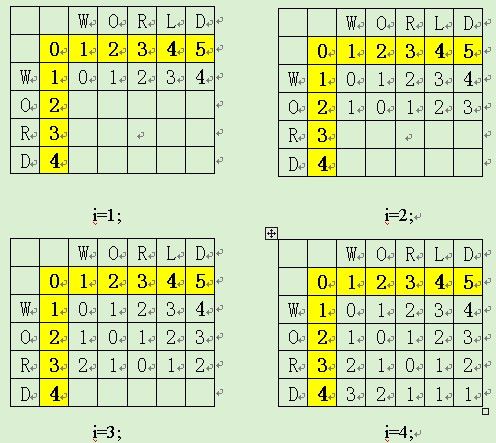Lucene的FuzzyQuery(模糊搜索)中用到的Levenshtein Distance(LD)算法
主题:Levenshtein Distance(LD);
相关介绍:Levenshtein distance是由俄国科学家Vladimir Levenshtein在1965年设计并以他的名字命名的。如果不能拼写或发Levenshtein音,通常可以称它edit distance(编辑距离);
用途:该算法用于判断两个字符串的距离,或者叫模糊度。个人理解就是差异程度。而差异的标准就是1)加一个字母(Insert),2)删一个字母(Delete),3改变一个字母(Substitute)。
算法描述:
| Step |
Description |
| 1 |
Set n to be the length of s.Set m to be the length of t. |
| 2 |
Initialize the first row to 0..n. |
| 3 |
Examine each character of s (I from 1 to n). |
| 4 |
Examine each character of t (j from 1 to m). |
| 5 |
If s[i] equals t[j], the cost is 0. |
| 6 |
Set cell d[I,j] of the matrix equal to the minimum of: |
| 7 |
After the iteration steps (3, 4, 5, 6) are complete, the distance is found in cell d[n,m]. |
1、 得到源串s长度n与目标串t的长度m,如果一方为的长度0,则返回另一方的长度。
2、 初始化(n+1)*(m+1)的矩阵d,第一行第一列的值为0增至对应的长度。
3、 遍历数组中的每一个字符(i,j从1开始)。如果s[i]与t[j]的值相等,cost值为0,否则为1。D[i][j]的值为d[i-1,j] + 1(左边的值加1)、d[I,j-1] + 1.(上边的值加1)、d[i-1,j-1] + cost (斜上角的值加cost) 中的最小者。
4、 等第三步遍历完后,右下角d[n,m]的值就为两个字符串的距离。
应用演示:source:word与target:world比较过程。
应用举例:据《开发自己的搜索引擎——Lucene 2.0+Heriterx
》记载P134页记载,lucene中FuzzyQuery(模糊匹配)就是应用该算法的;也可用于Spell checking(拼写检查),Speech recognition(语句识别),DNA analysis(DNA分析) ,Plagiarism detection(抄袭检测)。
参考资料:
http://www.merriampark.com/ld.htm
